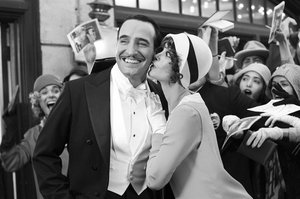THE AISLE SEAT - by Mike McGranaghan
"THE ARTIST"

This kiss changes the lives of both characters in The Artist.
In 1976, at the age of eight, my father took me to see Mel Brooks' Silent Movie. Even at such a young age, I knew it was gutsy to make a film without dialogue. The Artist, from French filmmaker Michel Hazanavicius, is even gutsier. Here, in 2011, is a silent film, shot in black and white, and projected in an era-appropriate square aspect ratio. This is no mere gimmick, though. The Artist takes place in the days of silent cinema, and it chooses to address its subject matter by being an example of it. The result is extraordinary. This is a wonderful film that kept me enthralled from first frame to last.
Jean Dujardin plays George Valentin, one of the biggest movie stars in the world. Although his marriage to wife Doris (Penelope Ann Miller) isn't going so great, his career is in the best place possible. One day, George gets his photo taken with a fan, an aspiring actress named Peppy Miller (Berenice Bejo). He's smitten with her, and insists that she be hired as an extra on his new picture, against the wishes of the studio chief, Al Zimmer (John Goodman). George and Peppy go their separate ways after filming a short, albeit electric, scene together. Soon afterward, her career starts to advance, first to bit parts, then to supporting roles. Meanwhile, Zimmer announces that the studio will no longer make silent films, instead transitioning to the new “talkies.” George thinks talkies are a fad, and petulantly quits, determined to make films on his own. Peppy, meanwhile, becomes a major star in the new format. She and George are not done with each other, though. Their paths, although going in different directions, converge again, revealing a bond that may or may not withstand their professional fortunes.
If The Artist had been made conventionally – in color, with sound, etc. - it would still be a very good movie. By making it as a silent film, it becomes a great movie. Somehow, people in silent films almost seem to be from another world. We don't hear their voices, or see a completely realistic version of what they looked like. Their movements are exaggerated to compensate for an inability to speak. They are somehow both real and unreal, simultaneously. Shooting conventionally can't recreate that paradox. Remember when Robert Downey, Jr. played Charlie Chaplin? He gave a very good performance, but did you feel like you were watching Chaplin? Hazanavicius gets around the problem by plunging us into the cinematic techniques of the era. His characters become authentic because of it.
The film's vintage style also immerses us in the divergent courses George and Peppy are on, which, in turn, heightens the emotions. Although set in “the business of show,” The Artist isn't simply about the movies. This is a film about change – how those who jump on the train succeed, and how those who don't get run over by it. Change scares George. He's done just fine by the status quo. If he fails to initially realize that the business is changing around him, it's only because he hasn't seen evidence of it until now. Peppy, meanwhile, sees a way to thrive using this new invention of sound recording. Her dream comes true, while his slowly dies. If you've ever been in the position of either capitalizing on something new or feeling like you were being put out to pasture, you'll likely identify with the themes.
Shooting congruously with the subject additionally allows the director to engage in some storytelling creativity. For example, we realize George fears the advent of the talkie during a nightmare sequence in which he is bombarded by noises. (It's one of the few times there is anything other than music on the soundtrack.) Other ideas are dealt with in similarly inventive ways. I repeatedly felt a sense of delight watching The Artist. Hazanavicius continually finds ways to surprise us and catch us off guard.
A film like this depends on the exact right casting. Jean Dujardin is magnificent as George Valentin. He looks like a matinee idol, but more importantly, he moves like one. We see George in a variety of different films – action, comedy, romance – and the actor makes him credible in each of them. He also does a superb job of tracking George's downward spiral into depression and self-pity. One scene, which represents the character's absolute low point, is especially powerful. Berenice Bejo is just as good. She captures the crucial characteristic of Peppy: she lights up the screen. Exuding tons of charisma without words, Bejo makes us believe that audiences would fall in love with Peppy. She brings a nice humanity to the part as well. Peppy does not develop a stereotypical ego after becoming a star. Quite the contrary, she recognizes the debt she owes to George. It is a debt she's inclined to repay.
The Artist fires on all cylinders. It's enormously entertaining, brilliantly made, and perfectly acted. It doesn't matter whether you love silent films or not. The story is strong enough to pull you in, and the style brings out all its best qualities. Everything culminates in a final scene that hits just the right note of optimistic realism. Whenever I see a great film, I get a literal high off it, almost like a drug. The feeling can last for days. The Artist gave me one of those highs. Do not, under any circumstances, miss this film.
(![]()
![]()
![]()
![]() out of four)
out of four)
The Artist is rated PG-13 for a disturbing image and a crude gesture. The running time is 1 hour and 40 minutes.
Buy a copy of my book, "Straight-Up Blatant: Musings From The Aisle Seat," on sale now at Lulu.com!


